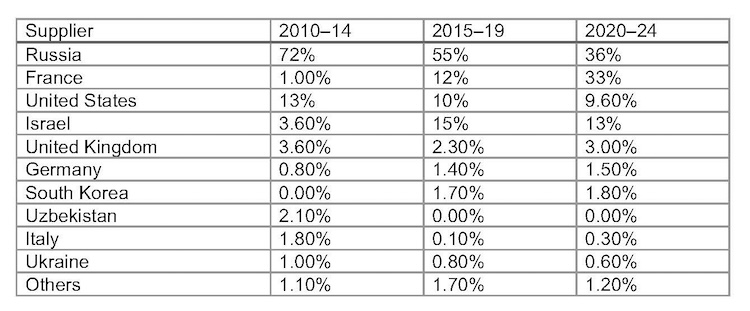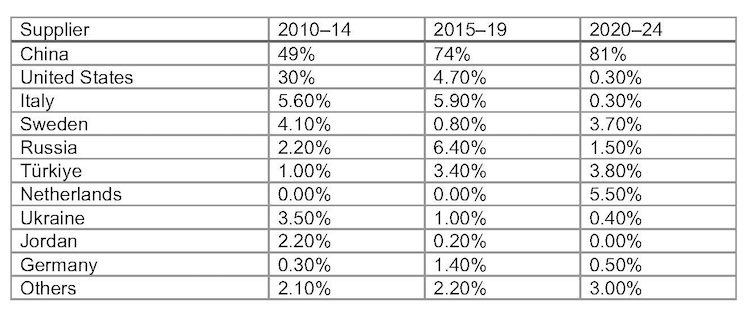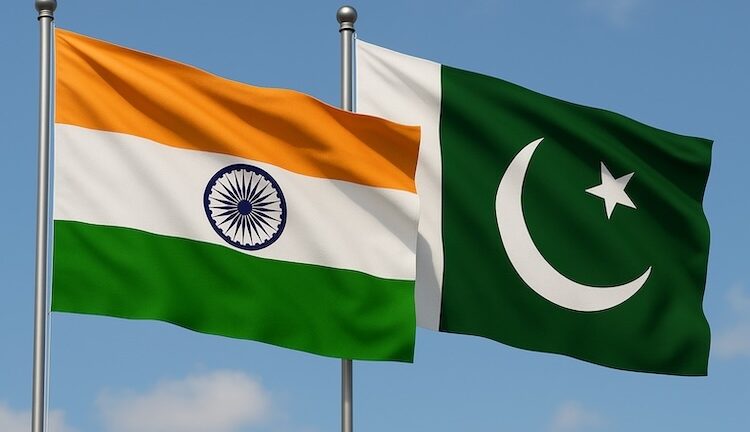By Thalif Deen*
NEW YORK | 9 May 2025 (IDN) — Will the rising military tension between two of the world’s heavily-armed nuclear powers –India and Pakistan—lead to a full-scale war?
The guessing game is on.
The two South Asian countries have long remained locked in a bitter confrontation, mostly over the disputed territory of Kashmir—a rivalry that stems from the 1947 partition of British India, with an Indian-administered Kashmir and a Pakistan-administered Kashmir.
According to the Stockholm International Peace Research Institute (SIPRI), both countries are heavily armed, with rising military expenditures over the years.
India, the world’s fifth biggest military spender in 2024, increased its spending to $86.1 billion, up by 1.6 per cent compared to 2023 and by 42 per cent compared to 2015. India, which is also one of the world’s largest arms importers, has a policy aimed at reducing its reliance on arms imports.
The policy, which earmarks 75 per cent of Indian capital outlays (equivalent to 22 per cent of total military spending) to fund domestic military procurement, has made significant progress over the years, with India now able to produce armoured vehicles, helicopters and submarines, says SIPRI.
However, it remains reliant on imports for some of the more advanced systems.
Pakistan’s military spending declined for the third consecutive year in 2024 to $10.2 billion. Its military budget actually increased by 17 per cent in nominal terms, as the country faces changes in both internal security and tensions with India in 2024. However, this was offset by deep economic crisis and high inflation, turning the change into a real-terms decline of 5.1 per cent.
Asked if India has a military advantage over Pakistan, Siemon Wezeman, Senior Researcher in the SIPRI Arms Transfers Programme, told IDN India is superior in numbers of major arms in use and personnel in service.
“Only in in the number of nuclear weapons India and Pakistan are estimated to be equals (see the data from SIPRI and this nice graphic.” – https://www.graphicnews.com/en/pages/46997/Military_balance).
However, he said, these raw numbers do not mean that much – for example, issues of quality, training, integration of the various weapons and units, doctrine and battle space context play a significant role in any assessment of the two forces and the outcome of the conflict, as shown also in other recent conflicts (e.g. Ukraine and Afghanistan).
Dr M V. Ramana, Professor and Simons Chair in Disarmament, Global and Human Security, School of Public Policy and Global Affairs, Graduate Program Director, MPPGA at the University of British Columbia, Vancouver, told IDN India does have a larger and more well-equipped military but it is not clear how much of an advantage that will translate into.
So far, he pointed out, the militaries of the two countries have been only sporadically striking each other and there has not been full-fledged war.
“News reports are unreliable and spokespeople from both countries have been making claims that have not been independently verified. But to the extent one can go by these reports, it looks like both countries are resorting to the use of drones, which are presumably cheap.”
Thus, at this stage, the greater amount of military equipment with India has not translated into any major advantage. This could change if the two countries embark on a full-fledged war, but that would raise the risk of the use of nuclear weapons, which would be tremendously destructive, declared Dr Ramana.
In a report titled “US arms one side: China arms the other” May 8, the New York Times hints at a proxy war between the US and China.
The Times quotes Ashley Tellis, a former diplomat and currently a senior fellow at the Carnegie Endowment for International Peace, as saying: “The US Is now central to India’s security interests while China increasingly plays a comparable role in Pakistan”.
Besides India and Pakistan, Asia also has two other nuclear powers: China and North Korea.
Offering his good offices as mediator, UN Secretary-General Antonio Guterres said “the world cannot afford another conflict between India and Pakistan. We encourage all efforts to de-escalate the situation and encourage both India and Pakistan to exercise maximum restraint”.
According to SIPRI, India was the world’s second largest arms importer in 2020–24 with an 8.3 per cent share of global imports. Indian arms imports decreased by 9.3 per cent between 2015–19 and 2020–24.
The drop was at least partly the result of India’s increasing ability to design and produce its own weapons, making it less reliant on imports. India has for example developed its own combat aircraft, warships and nuclear submarines, but remains dependent on exports key components for these products. These include engines and radars for the aircraft and warships.
Furthermore, India has continued to buy most of its key major weapons from abroad, including combat aircraft and submarines from France, combat aircraft, air defence systems and tanks from Russia, combat helicopters and anti-submarine aircraft from the US.
The largest share of India’s imports came from Russia (36 per cent); however, this was a significantly smaller share than in 2015–19 (55 per cent) and 2010–14 (72 per cent). India is shifting its arms-supply relations towards Western suppliers, most notably France, Israel and the US.
Despite recent public declarations from the two sides that relations between India and Russia remain friendly, the shift is also visible in India’s new and planned orders for major arms, most of which will come from Western suppliers, said SIPRI.
Percentage shares of suppliers of major arms to India between 2010 and 2024

Source SIPRI Arms Transfers Database, May 2025
Pakistan’s arms imports increased by 61 per cent between 2015–19 and 2020–24 as it started to receive deliveries—including of combat aircraft and frigates—under a large-scale arms procurement programme.
Pakistan accounted for 4.6 per cent of global arms imports in 2020–24, making it the world’s fifth largest arms importer.
China has supplied the largest share of Pakistan’s major arms imports in all five-year periods since 1990–94 and this share has continued to grow: China supplied 81 per cent of Pakistan’s arms imports in 2020–24, compared with 74 per cent in 2015–19.
Percentage shares of suppliers of major arms to Pakistan between 2010 and 2024

Source: SIPRI Arms Transfers Database, May 2025
Nuclear forces
Meanwhile, according to Hans M. Kristensen and Matt Korda who cover world nuclear forces in this chapter from SIPRI Yearbook 2024, Section VI deals with India, VII with Pakistan while Section X on Global stocks and production of fissile materials, 2023.
India
As of January 2024, India was estimated to have a growing stockpile of about 172 nuclear weapons—a small increase from the previous year (see table 3, reproduced below). These weapons were assigned to a maturing nuclear triad of aircraft, land-based missiles and nuclear-powered ballistic missile submarines (SSBNs).
It has long been assumed that India stores its nuclear warheads separately from its deployed launchers during peacetime. However, the country’s recent moves towards placing missiles in canisters and conducting sea-based deterrence patrols suggest that India could be shifting in the direction of mating some of its warheads with their launchers in peacetime.
The warhead estimate is based on calculations of India’s inventory of weapon-grade plutonium (see Section X of the chapter), the estimated number of operational nuclear-capable delivery systems, India’s nuclear doctrine, publicly available information on the Indian nuclear arsenal, and private conversations with defence officials.
The Indian government has provided little public information about the size of its nuclear forces, other than conducting occasional parade displays and announcing missile flight tests.
Pakistan
According to SIPRI estimates, Pakistan possessed approximately 170 nuclear warheads as of January 2024—the same number as the previous year (see table 4, reproduced below). These weapons were assigned to Pakistan’s nascent triad of aircraft, ground-launched ballistic and cruise missiles, and sea-launched cruise missiles.
The development of several new delivery systems and Pakistan’s growing accumulation of fissile material suggest that its nuclear weapon arsenal and fissile material stockpile are likely to continue to expand over the next decade, although projections vary considerably.
The Pakistani government has never publicly disclosed the size of its nuclear arsenal. Limited official public data and exaggerated news stories about Pakistan’s nuclear weapons mean that analysing the number and types of Pakistani warheads and delivery vehicles is fraught with uncertainty.
SIPRI’s estimates of Pakistan’s nuclear forces thus come with less confidence than those for most other nuclear-armed countries.

*Thalif Deen is a former Director, Foreign Military Markets at Defense Marketing Services (DMS); Senior Defense Analyst at Forecast International; military editor Middle East/Africa at Jane’s Information Group and UN correspondent for Jane’s Defence Weekly, London. A Fulbright scholar with a Master’s Degree (MSc) in Journalism from Columbia University, New York, he is the author of the 2021 book on the United Nations titled “No Comment – and Don’t Quote me on That”. The link to Amazon via the author’s website follows https://www.rodericgrigson.com/no-comment-by-thalif-deen/ [IDN-InDepthNews]
Image showing flags of India and Pakistan. Credit: ChatGPT


